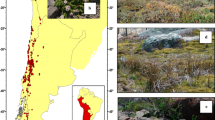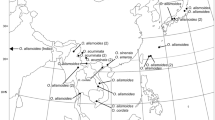Abstract
Limosella is a small aquatic genus of Scrophulariaceae of twelve species, of which one is distributed in northern circumpolar regions, two in southern circumpolar regions, two in the Americas, one endemic to Australia, and six in tropical or southern Africa or both. The Australasian L. curdieana has always been considered distinct but its close phylogenetic relationships have never been inferred. Here, we investigated the following alternative phylogenetic hypotheses based on comparative leaf morphology and habitat preferences or floral morphology: (1) L. curdieana is sister to the African L. grandiflora; or (2) it is closely related to a group of other African species and the northern circumpolar L. aquatica. We tested these hypotheses in a phylogenetic framework using DNA sequence data from four plastid DNA regions and the nuclear ITS region. These were analyzed using maximum parsimony and Bayesian inference. We obtained moderately resolved, partially conflicting phylogenies, supporting that accessions of L. grandiflora form the sister group to the rest of the genus and that L. curdieana groups with the African taxa, L. africana and L. major, and L. aquatica. Thus, the molecular evidence supports the second hypothesis. A biogeographic analysis suggests an out-of-southern Africa scenario and several dispersal events in the Southern Hemisphere. Past dispersal from southern Africa to Australasia is suggested, yet it cannot be excluded that a route via tropical Africa and temperate Asia has existed.





Similar content being viewed by others
References
Baldwin BG (1992) Phylogenetic utility of the internal transcribed spacers of nuclear ribosomal DNA in plants: an example from the Compositae. Mol Phylogenet Evol 1:3–16
Barker WR (1986) Limosella. In: Jessop JP, Toelken HR (eds) Flora of South Australia, vol 3., Polemoniaceae to compositeABRS/CISRO, Melbourne, pp 1282–1284
Barker WR (1999) Limosella. In: Walsh NG, Entwisle TJ (eds) Flora of Victoria, vol 4., Dicotyledons cornaceae to asteraceaeInkata Press, Port Melbourne, pp 497–498
Bell CD, Soltis DE, Soltis PS (2010) The age and diversification of the angiosperms re-revisited. Am J Bot 97:1296–1303
Boere GC, Stroud DA (2006) The flyway concept: what it is and what it isn’t. In: Boere GC, Galbraith CA, Stroud DA (eds) Waterbirds around the world. The Stationery Office, Edinburgh, pp 40–47
Brako L, Zarucchi JL (1993) Catalogue of the flowering plants and gymnosperms of Peru. Monographs in Systematic Botany volume 45, Missouri Botanical Garden, St. Louis, MO
Cook CDK (2004) Aquatic and wetland plants of southern africa. Backhuys Publishers, Leiden
Crisp MD, Cook LG (2013) How was the Australian Flora assembled over the last 65 million years? A molecular phylogenetic perspective. Annu Rev Ecol Evol Syst 44:303–324
Crow GE, Hellquist CB (2000) Limosella. In: Crow GE, Hellquist CB (eds) Aquatic and wetland plants of northeastern North America, vol 1., Pteridophytes, gymnosperms, and angiosperms: dicotyledonsThe University of Wisconsin Press, Madison, pp 327–329
Darwin C (1872) The origin of species by means of natural selection. John Murray, London
Drummond AJ, Rambaut A (2007) BEAST: Bayesian evolutionary analysis by sampling trees. BMC Evol Biol 7:214–222
Drummond AJ, Ho SYW, Phillips MJ, Rambaut A (2006) Relaxed phylogenetics and dating with confidence. PLoS Biol 4:e88
Farris JS, Källersjö M, Kluge AG, Bult C (1994) Testing significance of incongruence. Cladistics 10:315–319
Felsenstein J (1985) Confidence limits on phylogenies—an approach using the bootstrap. Evolution 39:783–791
Ghazanfar SA, Hepper FN, Philcox D (2008) Scrophulariaceae. In: Beentje HJ, Ghazanfar SA (eds) Flora of tropical East Africa. Published on behalf of the East African governments by Royal Botanic Gardens, Kew, UK, pp 1–211
Glück K (1934) Novae species et varietates generis Limosellae. Notizblatt des Botanischen Gartens und Museums zu Berlin-Dahlem 12:71–78
Godfrey RK, Wooten JW (1981) Limosella. In: Godfrey RK, Wooten JW (eds) Aquatic and wetland plants of southeastern United States Dicotyledons. Univ Georgia Press, Athens, p 649
Gorshkova SG (1997) Limosella L. In: Schischkin BK, Bobrow EG (eds) Flora of U.S.S.R. vol 22, pp 367–369
Harden GJ (1992) Limosella. Flora of New South Wales, vol 3. New South Wales University Press, Australia, pp 563–564
Heled J, Drummond A (2010) Bayesian inference of species trees from multilocus data. Mol Biol Evol 27:570–580
Hilliard OM, Burtt BL (1986) Notes on some plants of southern Africa chiefly from Natal: XII. Notes R Bot Gard Edinb 43:189–228
Hong DY, Yang H, Jin CL, Holmgren NH (1998) Scrophulariaceae. In: Wu ZY, Raven PH (eds) Flora of China. Science Press, Beijing, pp 1–212
Ito Y, Ohi-Toma T, Murata J, Tanaka N (2010) Hybridization and polyploidy of an aquatic plant, Ruppia (Ruppiaceae), inferred from plastid and nuclear DNA phylogenies. Am J Bot 97:1156–1167
Ito Y, Tanaka N, García-Murillo P, Muasya AM (2016) A new delimitation of the Afro-Eurasian plant genus Althenia to include its Australasian relative, Lepilaena (Potamogetonaceae)—Evidence from DNA and morphological data. Mol Phylogenet Evol 98:261–270
Ivanina LI (2001) Limosella. In: Fedorov AA (ed) Flora of Russia, the European part and bordering regions, vol 5. A. A. Balkema, Rotterdam, pp 325–347
Katoh K, Standley DM (2013) MAFFT multiple sequence alignment software version 7: improvements in performance and usability. Mol Biol Evol 30:772–780
Kokubugata G, Nakamura K, Forster PI, Hirayama Y, Yokota M (2012) Antitropical distribution of Lobelia species (Campanulaceae) between the Ryukyu Archipelago of Japan and Oceania as indicated by molecular data. Aust J Bot 60:417–428
Kornhall P, Bremer B (2004) New circumscription of the tribe Limoselleae (Scrophulariaceae) that includes the taxa of the tribe Manuleeae. Bot J Linn Soc 146:453–467
Little DP, Barrington DS (2003) Major evolutionary events in the origin and diversification of the fern genus Polystichum (Dryopteridaceae). Am J Bot 90:508–514
Miller MA, Pfeiffer W, Schwartz T (2010) Creating the CIPRES science gateway for inference of large phylogenetic trees. In: Proceedings of the Gateway Computing Environments Workshop (GCE), 14 Nov. 2010, New Orleans, LA, USA, pp 1–8
Moore LB (1961) Limosella. In: Allan HH (ed) Flora of New Zealand, vol l., Government printerWellington, New Zealand, pp 846–847
Moore TE, Verboom GA, Forest F (2010) Phylogenetics and biogeography of the parasitic genus Thesium L. (Santalaceae), with an emphasis on the Cape of South Africa. Bot J Linn Soc 162:435–452
Mort ME, Soltis DE, Soltis PS, Francisco-Ortega J, Santos-Guerra A (2001) Phylogenetic relationships and evolution of Crassulaceae inferred from matK sequence data. Am J Bot 88:76–91
Müller S, Salomo K, Salazar J, Naumann J, Jaramillo MA, Neinhuis C, Feild TS, Wanke S (2015) Intercontinental long-distance dispersal of Canellaceae from the New to the Old World revealed by a nuclear single copy gene and chloroplast loci. Mol Phylogenet Evol 84:205–219
Muńoz J, Felicisimo ÁM, Cabezas F, Burgaz AR, Martínez I (2004) Wind as a long- distance dispersal vehicle in the Southern Hemisphere. Science 304:1144–1147
Nakamura K, Denda T, Kokubugata G, Forster PI, Wilson GW, Peng C, Yokota M (2012) Molecular phylogeography reveals an antitropical distribution and local diversification of Solenogyne (Asteraceae) in the Ryukyu Archipelago of Japan and Australia. Biol J Linn Soc 105:197–217
Norup MF, Petersen G, Burrows S, Bouchenak-Khelladi Y, Leebens-Mack J, Pires JC, Linder HP, Seberg O (2015) Evolution of Asparagus L. (Asparagaceae): out-of-South-Africa and multiple origins of sexual dimorphism. Mol Phylogenet Evol 92:25–44
Nylander JAA (2002) MrModeltest v.1.0. Program distributed by the author. Department of Systematic Zoology, Uppsala University, Uppsala. Available at: http://www.ebc.uu.se/systzoo/staff/nylander.html
Olmstead RG, Sweere JA (1994) Combining data in phylogenetic systematics: an empirical approach using three molecular data sets in the Solanaceae. Syst Biol 43:467–481
Oxelman B, Lidén M, Berglund D (1997) Chloroplast rps16 intron phylogeny of the tribe Sileneae (Caryophyllaceae). Plant Syst Evol 206:393–410
Oxelman B, Backlund M, Bremer B (1999) Relationships of the Buddlejaceae s. l. inferred from chloroplast rbcL and ndhF sequences. Syst Bot 24:164–182
Oxelman B, Komhall P, Olmstead RG, Bremer B (2005) Further disintegration of Scrophulariaceae. Taxon 54:411–425
Philcox D (1990) Limosella. In: Launert E, Pope GV (eds) Flora Zambesiaca, volume 8, part 2. Flora Zambesiaca Managing Committee, London, pp 73–75
Rambaut A (2009) FigTree v1.3.1: Tree Figure Drawing Tool. http://tree.bio.ed.ac.uk/software/figtree/
Rambaut A, Suchard MA, Xie W, Drummond AJ (2014) Tracer. Ver 1.6. http://beast.bio.ed.ac.uk/Tracer
Ronquist F, Huelsenbeck JP (2003) MrBayes 3: Bayesian phylogenetic inference under mixed models. Bioinformatics 19:1572–1574
Ronquist F, Teslenko M, van der Mark P, Ayres DL, Darling A, Höhna S, Larget B, Liu L, Suchard MA, Huelsenbeck JP (2012) MrBayes 3.2: efficient Bayesian phylogenetic inference and model choice across a large model space. Syst Biol 61:539–542
Rønsted N, Symonds MRE, Birkholm T, Christensen SB, Meerow AW, Molander M, Mølgaard P, Petersen G, Rasmussen N, van Staden J, Stafford GI, Jäger AK (2012) Can phylogeny predict chemical diversity and potential medicinal activity of plants? A case study of Amaryllidaceae. BMC Evol 12:182
Swofford DL (2002) PAUP*: Phylogenetic analysis using parsimony (*and other methods), version 4.0b. Sinauer, Sunderland, Massachusetts, USA
Taberlet P, Ludovic G, Pautou G, Bouvet J (1991) Universal primers for amplification of three non-coding regions of chloroplast DNA. Plant Mol Biol 17:1105–1109
Webb DA (1972) Limosella. In: Tutin TG, Burges NA, Chater AO, Edmondson JR, Heywood VH, Moore DM, Valentine DH, Walters SM, Webb DA (eds) Flora Europaea, vol 3, pp 205–216
Wolf PG, Soltis PS, Soltis DE (1994) Phylogenetic relationships of Dennstaedtioid ferns: evidence from rbcL sequences. Mol Phylogenet Evol 3:383–392
Yamazaki T (1993) Limosella. In: Iwatsuki K, Yamazaki T, Boufford DE, Ohba H (eds) Flora of Japan, vol IIIa. Angiospermae Dicotyledoneae Sympetalae, Kodansha, p 334
Yang Z, Rannala B (1997) Bayesian phylogenetic inference using DNA sequences: a Markov Chain Monte Carlo method. Mol Biol Evol 14:717–724
Yu Y, Harris AJ, Blair C, He X (2015) RASP (Reconstruct Ancestral State in Phylogenies): a tool for historical biogeography. Mol Phylogenet Evol 87:46–49
Acknowledgements
The authors thank R. Kaul (NEB) for providing Limosella materials, T. Trinder-Smith (BOL), J. Palmer (CANB), C. Gallagher, P. Milne (MEL), C. Cupido (NBG), and E. van Wyk (PRE) for arranging loans from their institutions and/or for hospitality during our research visits; M. Hjertson (UPS) for sending scanned images of voucher specimens of Limosella at UPS; C. Ishii (Tsukuba) for help with DNA sequencing; J. Guerin (South Australian Seed Conservation Center, Australia) for providing L. curdieana photos. We would also like to thank P. B. Pelser (CANU), J. Murata, H. Ikeda, and T. Ohi-Toma (TI), and J. Li (Kunming) for their continuous encouragements and supports. YI and AMM received plant collecting permit in Western Cape, South Africa from Cape-Nature. This research was supported by FY 2012 Researcher Exchange Program between Japan society for the promotion of science (JSPS) and Royal Society of New Zealand (RSNZ) to YI, JSPS KAKENHI Grant Number 25440224 to NT, and the South African National Research Foundation (NRF) to AMM.
Author information
Authors and Affiliations
Corresponding author
Electronic supplementary material
Below is the link to the electronic supplementary material.
Rights and permissions
About this article
Cite this article
Ito, Y., Tanaka, N., Albach, D.C. et al. Molecular phylogeny of the cosmopolitan aquatic plant genus Limosella (Scrophulariaceae) with a particular focus on the origin of the Australasian L. curdieana . J Plant Res 130, 107–116 (2017). https://doi.org/10.1007/s10265-016-0872-6
Received:
Accepted:
Published:
Issue Date:
DOI: https://doi.org/10.1007/s10265-016-0872-6




